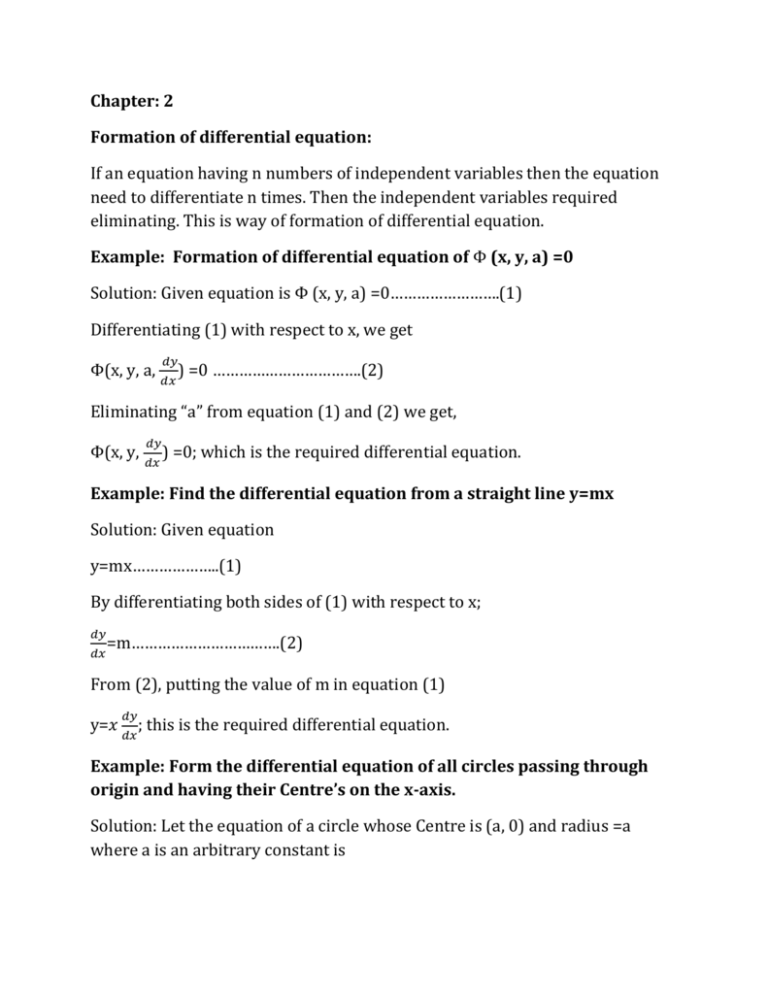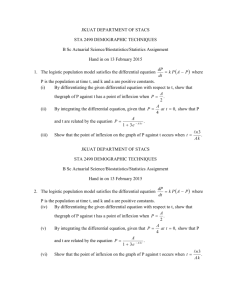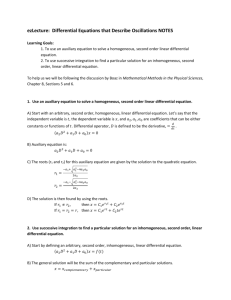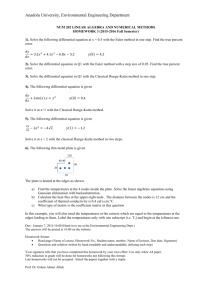Formation of differential Equation(chapter-2) - Prof-desk
advertisement

Chapter: 2 Formation of differential equation: If an equation having n numbers of independent variables then the equation need to differentiate n times. Then the independent variables required eliminating. This is way of formation of differential equation. Example: Formation of differential equation of Φ (x, y, a) =0 Solution: Given equation is Φ (x, y, a) =0…………………….(1) Differentiating (1) with respect to x, we get Φ(x, y, a, 𝑑𝑦 𝑑𝑥 ) =0 …………………………….(2) Eliminating “a” from equation (1) and (2) we get, Φ(x, y, 𝑑𝑦 𝑑𝑥 ) =0; which is the required differential equation. Example: Find the differential equation from a straight line y=mx Solution: Given equation y=mx………………..(1) By differentiating both sides of (1) with respect to x; 𝑑𝑦 𝑑𝑥 =m…………………………….(2) From (2), putting the value of m in equation (1) y=𝑥 𝑑𝑦 𝑑𝑥 ; this is the required differential equation. Example: Form the differential equation of all circles passing through origin and having their Centre’s on the x-axis. Solution: Let the equation of a circle whose Centre is (a, 0) and radius =a where a is an arbitrary constant is (x − a)2 + (y − 0)2 = 𝑎2 Or, 𝑥 2 -2ax+𝑎2 +𝑦 2 =𝑎2 Or, 𝑥 2 + 𝑦 2 = 2ax ………………………..(1) By differentiating (1) with respect to x, 𝑑𝑦 2x+2y =2a………………….(2) 𝑑𝑥 Multiplying both sides by x of equation (2), 𝑑𝑦 2𝑥 2 + 2xy =2ax 𝑑𝑥 𝑑𝑦 Or, 2𝑥 2 + 2xy 𝑑𝑥 𝑑𝑦 𝑥 2 - 𝑦 2 + 2xy 𝑑𝑥 =𝑥 2 + 𝑦 2 ……………………………. [from equation (1)] =0; This is the required differential equation. Example: Form a differential equation from relation y= Acos 𝑥+Bsin 𝑥 Solution: Given Equation, y= Acos 𝑥+Bsin 𝑥…………………..(1) By differentiating equation (1) with respect to x we get 𝑑𝑦 𝑑𝑥 = -Asin 𝑥+ Bcos 𝑥………………….(2) Again differentiating (2) with respect to x we get, 𝑑2𝑦 d𝑥 2 = - [Acos 𝑥+ Bsin 𝑥] Or, 𝑑2𝑦 Or, 𝑑2𝑦 d𝑥 2 d𝑥 2 = -y……….[ From equation (1)] +y=0; This is the required differential equation. Example: Show that the differential equation of A𝒙𝟐 +B𝒙𝟐 =1 is 𝑑2𝑦 𝑑𝑦 𝑑𝑦 d𝑥 𝑑𝑥 𝑑𝑥 x[y + ( )2 ] = y 2 Solution: Given equation, A𝑥 2 +B𝑥 2 =1………………………(1) By differentiating equation (1) with respect to x we get, 𝑑𝑦 2Ax+2By Or, By Or, 𝑑𝑦 𝑑𝑥 𝑦 𝑑𝑦 𝑥 𝑑𝑥 𝑑𝑥 =0 =-Ax 𝐴 = - …………………………….(2) 𝐵 Again differentiating equation (2) with respect to x we get, 𝑦 𝑑 𝑑𝑦 𝑑 𝑦 𝑑𝑦 𝑥 𝑑𝑥 𝑑𝑥 𝑑𝑥 𝑥 𝑑𝑥 ( )+ Or, 𝑦 𝑑2𝑦 Or, 𝑦 𝑑2𝑦 Or, 𝑦 𝑑2𝑦 𝑥 𝑥 + [ d𝑥 2 𝑥 d𝑥 2 + d𝑥 2 Or, 𝑥𝑦 𝑑2𝑦 d𝑥 2 𝑑2𝑦 Or, x[y d𝑥 2 ( ) =0 𝑑𝑦 )−y.1 𝑑𝑥 𝑥2 x( 1 𝑥2 𝑑𝑦 [x 𝑑𝑥 ]. 𝑑𝑦 𝑑𝑥 =0 − 𝑦] =0 1 𝑑𝑦 𝑦 𝑑𝑦 𝑥 𝑑𝑥 𝑥 2 𝑑𝑥 + ( )2 = 𝑑𝑦 𝑑𝑦 𝑑𝑥 𝑑𝑥 +x( )2 =y 𝑑𝑦 𝑑𝑦 𝑑𝑥 𝑑𝑥 + ( )2 ] = y (showed) Example: Prove the differential equations of all parabolas whose axes are parallel to y-axis is 𝒅𝟑 𝐲 𝐝𝒙𝟑 =0. Solution: The equation of all parabolas, whose axes are parallel to y-axis is (x − h)2 = 4a(y-k)……………………….(1) When a, h, k are arbitrary constants. Differentiating both sides of (1) with respect to x (1) we get, 𝒅𝒚 2(x-h) = 4a 𝒅𝒙 𝒅𝒚 Or, (x-h) = 2a 𝒅𝒙 Again differentiating both sides with respect to x we get, 𝑑2𝑦 1=2a Or, d𝑥 2 𝑑2𝑦 d𝑥 2 = 1 2𝑎 Again differentiating with respect to x we get, 𝑑3y d𝑥 3 =0 (proved) Example: Form a differential equation for a cardio ide r=a (1+𝐜𝐨𝐬 𝜽) Solution: Given equation, r=a (1+cos 𝜃)……………….(1) Differentiating both sides with respect to 𝜃 we get, 𝑑𝑟 𝑑𝜃 = -asin 𝜃 Or, a= - 1 𝑑𝑟 sin 𝜃 𝑑𝜃 Now putting the value of “a” in equation (1) we get, r=- 1 sin 𝜃 (1 + cos 𝜃) rsin 𝜃= -(1 + cos 𝜃) 𝑑𝑟 𝑑𝜃 𝑑𝑟 𝑑𝜃 rsin 𝜃+(1 + cos 𝜃) 𝑑𝑟 𝑑𝜃 =0 This is the required differential equation.








